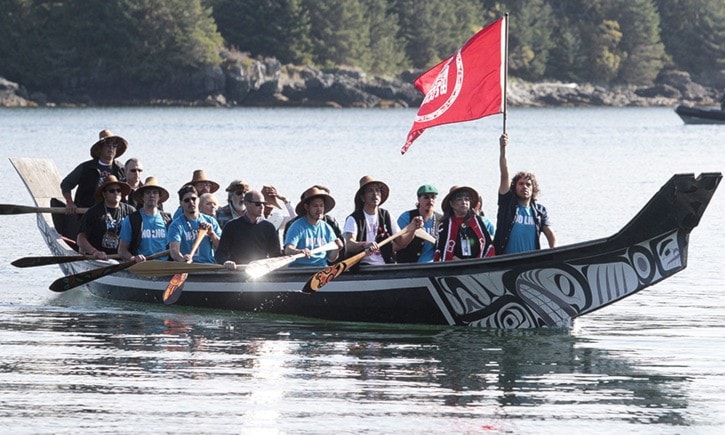Holding blue ‘No LNG’ signs and singing Haida songs, more than 100 people joined an impromptu rally against Pacific NorthWest LNG in Skidegate last week.
The rally came a day after the federal government conditionally approved the $11.4-billion liquefied natural gas plant and marine terminal planned for Lelu Island south of Prince Rupert.
“Everyone looks very, very colourful on this disheartening evening,” Desi Collinson, who organized the rally at the George Brown Recreation Centre, said.
Collinson later joined colleagues on the Skidegate Saints basketball team in wearing bright blue ‘No LNG’ T-shirts while they paddled a canoe with the visiting Duke and Duchess of Cambridge.
Barbara Wilson, who is doing her master’s thesis on alternative energy, said at the rally the LNG approval changed the way she feels about the Trudeau government.
“I’m really disappointed,” she said.
“I thought he would do better.”
Billy Yovanovich, Chief Councillor of Skidegate, said he was shocked by the decision.
“We don’t support it, and we’re going to stand by that,” he said, voicing concern that it will harm salmon in the Skeena River estuary.
“Sure, economic development isn’t where we wanted it to be,” added Yovanovich.
“But we’re slowly getting there, and one thing we’re not going to sacrifice is our food.”
If built, Pacific NorthWest LNG will add nearly $2.4 billion per year to Canada’s GDP and up to $36 billion in one-time capital investment — the largest in Canadian history. The project is also expected to hire 4,500 construction and 630 permanent workers.
Eventually, the LNG terminal would export up to 20 million tonnes of B.C. natural gas to Asia each year for the next 30 years.
About one 315-metre LNG ship would travel north of Haida Gwaii each day.
Environment Minister Catherine McKenna said the project was only approved after detailed environmental impact studies and consultations with First Nations.
McKenna noted that Pacific NorthWest LNG has 190 legally binding environmental conditions, including an emissions cap and First Nations monitoring.
“I am confident that we will minimize the environmental impacts of the project and ensure it proceeds in the most sustainable manner possible,” she said during the approval announcement.
A three-year review by the Canadian Environmental Assessment Agency found the project will have two significant environmental impacts.
In its final report, the CEAA concluded that noise and light from the project will cause significant harm to local harbour porpoises and, even after some engineering upgrades, it will raise B.C.’s total greenhouse gas emissions by about 7.2 per cent — enough to make it “one of the largest greenhouse gas emitters in Canada.”
The CEAA report estimates that the entire project, including “upstream” emissions from shale gas wells, will emit between 8.8 to 9.3 million tonnes of C02 equivalent per year, which is about equal to the pollution from 1.9 million cars.
Led by Malaysia’s Petronas, Pacific NorthWest LNG is owned by a consortium of other state firms from China, India, Japan, and Brunei.
Shortly after the approval was announced, Adnan Zainal Abidin, president of Pacific NorthWest LNG, said in a statement that the company will do a “total review” of the project in the coming months.
Worldwide, prices for natural gas have fallen due to oversupply.
But a report that Petronas was already thinking about selling its share of the project of Pacific NorthWest LNG was quickly dismissed by B.C.’s Ministry of Natural Gas Development, which said it was assured that is incorrect.
The ministry expects the global market for natural gas to rebound in the next four to 10 years, noting that Pacific NorthWest LNG would take several years to build.
The Council of the Haida Nation remains opposed to the project and its related shipping traffic. No shipping traffic west of the Hecate Strait was examined in the CEAA report.
Six First Nation along the Skeena River corridor are also opposed, concerned about the effect it may have on salmon migrating into their traditional territories.
But of the five Tsimshian First Nations whose rights and title the CEAA said would be directly affected, four have signed benefit agreements with Pacific NorthWest LNG.
While some critics dispute the findings, the CEAA report found the Lelu Island terminal is unlikely to cause significant harm to salmon and other marine fish, noting that the company has agreed to relocate the LNG terminal just off Flora Bank, an eelgrass habitat, using a 2.7-km jetty and 1.6-km suspension bridge.
Although its construction would destroy 1,800 square metres of eelgrass and 6,800 square metres of rock habitat suited to juvenile salmon and other fish, Pacific NorthWest LNG has identified five other areas where it could plant offsetting eelgrass as well as new subtidal and intertidal reef habitats, plus new cobble and gravel beaches.
The CEAA report also dismissed a study that found Flora Bank is at risk of being swept away by changes to local ocean currents, noting that oceanic processes in the area are naturally highly variable.
